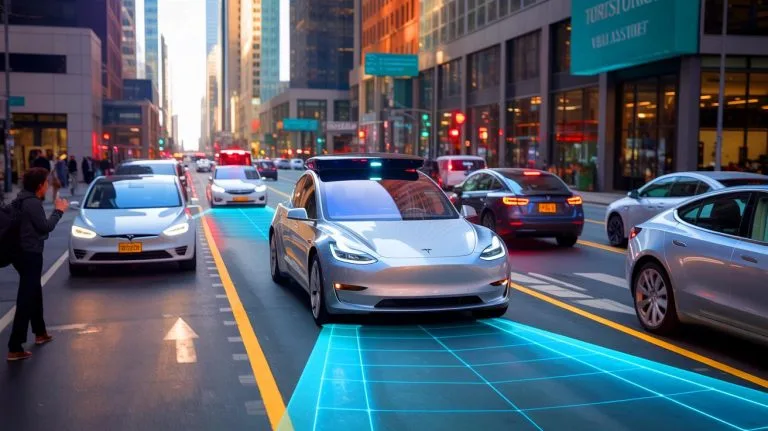| IN A NUTSHELL |
|
When Tesla first unveiled its ambitious plan for Full Self-Driving (FSD), it promised a revolution in the automotive industry, envisioning a future where cars would drive themselves with minimal human intervention. Enthusiastic customers bought into this vision, many paying up to $15,000 for FSD packages with the expectation of fully autonomous vehicles. However, as we find ourselves in 2025, the dream of a fully autonomous Tesla remains elusive. The company now faces growing skepticism about its ability to deliver on its promises, raising questions about the future of autonomous driving and Tesla’s role in it.
The Evolution of Tesla’s Full Self-Driving Promise
Since 2018, Tesla CEO Elon Musk has consistently assured customers and investors that Full Self-Driving capabilities were just around the corner. Despite these assurances, Tesla’s vehicles remain at Level 2 autonomy, as defined by the Society of Automotive Engineers (SAE). This level requires the driver to monitor the vehicle and be ready to take control at any time. The company’s shifting definition of FSD has led to confusion and frustration among consumers who expected more.
In a recent filing with the Securities and Exchange Commission, Tesla outlined a compensation package for Musk tied to “10 million active FSD subscriptions,” sparking further debate about the company’s commitment to achieving full autonomy. The filing’s vague language has fueled speculation that Tesla is hedging its bets, potentially redefining FSD to encompass less ambitious goals. This ambiguity has not only frustrated consumers but has also drawn scrutiny from regulators and industry experts.
Regulatory Challenges and Industry Comparisons
While Tesla has faced criticism for its FSD program, it is not alone in the struggle to achieve higher levels of vehicle autonomy. Regulatory hurdles, safety concerns, and technological limitations have slowed the progress of autonomous driving worldwide. Companies like Mercedes-Benz and Honda have made strides with Level 3 autonomy, offering systems that allow limited hands-free driving under specific conditions. However, these advancements are still a far cry from the full autonomy promised by Tesla.
In the consumer market, no company has yet achieved Level 4 autonomy, which would allow for fully autonomous driving without human intervention under certain conditions. While robotaxi services like Waymo and Baidu Apollo have deployed Level 4 vehicles in controlled environments, the leap to consumer vehicles remains significant. Tesla’s aggressive marketing strategy has set high expectations, but the reality of autonomous driving technology is far more complex and challenging than initially anticipated.
The Impact of Legal and Market Pressures
Legal and regulatory pressures have forced Tesla to reevaluate its FSD program. The National Transportation Safety Board has criticized Tesla’s FSD as “misleading,” and the California Department of Motor Vehicles has sued the company for fraudulent advertising. In response, Tesla has rebranded its system as “Full Self-Driving (Supervised)” in an attempt to clarify its capabilities and mitigate legal risks.
Market dynamics have also influenced Tesla’s approach. The cost of the FSD package has dropped by $7,000 from its peak in 2023, coinciding with a decline in Tesla’s sales. This price adjustment reflects the company’s need to remain competitive in an industry where technological advancements are slow and costly. As competitors continue to develop their own autonomous systems, Tesla must navigate a complex landscape of consumer expectations, regulatory requirements, and technological challenges.
Future Prospects and Consumer Trust
Despite the setbacks and challenges, the pursuit of fully autonomous vehicles remains a key focus for Tesla and the automotive industry at large. The potential benefits of autonomous driving, such as improved safety and efficiency, continue to drive innovation and investment. However, Tesla’s journey highlights the importance of transparency and realistic goal-setting in maintaining consumer trust.
The gap between marketing promises and technological realities has become increasingly apparent, and Tesla’s rebranding efforts may not be enough to satisfy consumers who feel misled. As the industry moves forward, companies must balance ambition with honesty to build lasting relationships with their customers. The question that remains is how Tesla and other automakers will adapt to these evolving expectations and what this means for the future of autonomous driving.
As Tesla navigates the complexities of delivering on its FSD promises, it must address the disparity between consumer expectations and the current capabilities of its technology. The company’s ability to regain trust and lead the charge toward full autonomy will depend on its willingness to engage transparently with both consumers and regulators. With the autonomous driving landscape still in flux, the crucial question is: how will Tesla redefine its role in shaping the future of transportation?
Did you like it? 4.4/5 (21)






